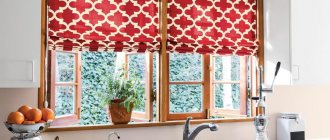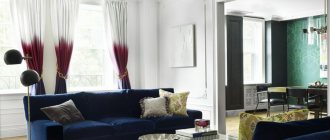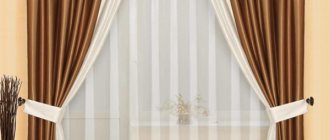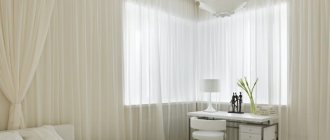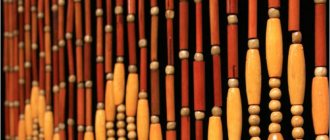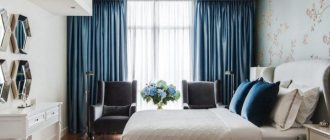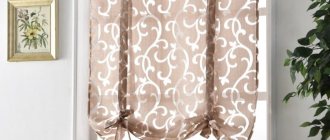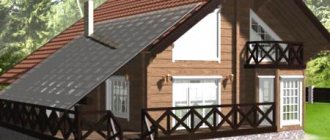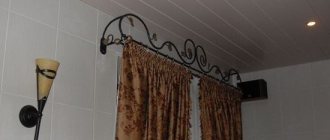Preparing for work
- The first is choosing a curtain model and correlating it with the shape and proportions of the window.
- The second is creating a pattern and transferring it to paper in full size.
- Third is the choice of fabric and calculation of its consumption.
- Fourth - preparing tools and materials for sewing and finishing: drapery tape, bias tape, fringe, thread, lining fabric, etc.
It is advisable for novice dressmakers to use ready-made patterns for lambrequins, which can be found in magazines, freely available on the Internet, or ordered from specialists. If you want to make patterns with your own hands, then it is better to start with simple models. After all, once the sewing is finished, nothing can be corrected.
What is a rigid lambrequin?
Drawing of a rigid lambrequin.
A rigid or straight lambrequin is called a gang. Making a rigid lambrequin involves the presence of a wooden base or a sheet of plywood; such a decorative element is best left to experienced builders. And you can sew a bandeau from the material yourself.
In order for the lambrequin to be rigid, it should be duplicated with fabric with a denser structure. You can choose different duplicating materials: it can be thick non-woven or lining fabric, which ideally retains the shape of the panel.
You can buy a bandeau with an adhesive base, which is shown in Fig. 1. The bandeau is sold in various thicknesses; it may have a foam base, which does not require the use of lining material. On the reverse side, the bandeau is sometimes velor with a light brown tint. It is best not to use a smooth or glossy fabric, since every error will be clearly visible.
The lambrequins are secured with eyelets in front of the cornice on a special strip. The folds of soft lambrequins are called swag. The size of the folds determines the amount of material needed.
Figure 1. Varieties of bandeau.
You can make a rigid lambrequin using a simple or complex method. Various compositions are made from materials with a soft or hard structure, as shown in Fig. 2.
When choosing fabric for rigid lambrequins, you should carefully consider the main color of the material. It is necessary that it harmonizes with the interior of the room. A rigid type product can be made from any fabric used for finishing, excluding those that are too light or delicate.
Recommendations for creating a bandeau with your own hands
For those beginning to learn how to make this type of product, it is better to first sew it for the kitchen. The tailoring itself will not be associated with the invention of special patterns. The design of a gang window will be perfect for any room. For example, if you plan to make a bandeau from cotton fabric, then you can use a lace frill for decoration.
Before work, prepare the fabric, checking it for defects, and then iron it.
You can iron with steam, which will avoid shrinkage of the material. Only after this the workpiece cut according to the template is cut off. The following tools and materials will help you make a gang with your own hands:
- lambrequin base made of thick fabric or adhesive tape 45 cm wide;
- sewing machine;
- iron;
- scissors;
- Decoration Materials;
- duct tape.
Figure 2. Lambrequin pattern.
Step-by-step sewing is carried out based on the instructions:
- A special pattern is applied to the material, the outline of the part is drawn along its edges and cut out.
- The material is ironed.
- The cut material is glued onto the finished base, ironing it.
- Excess fabric from the edges is trimmed to 5 cm.
- The material is applied to the lining.
- Using pins, carefully pierce the prepared base with the glued fabric on 3 sides, without touching the top cut.
- Stepping back 1 cm from each edge, lay a machine line.
- Excess tissue is cut off.
- Straighten the product from the wrong side to the front side.
- Using pins, pin the lambrequin from the top edge.
- The adhesive tape is attached from the top edge.
- The tape is sewn on a sewing machine.
- After processing, the fabric along the edge with Velcro is removed.
- Then the adhesive tape should be turned the other side up.
If the described method of sewing this type of product seems complicated, then the panel can be sewn without using a base. The finishing materials along the edge are strengthened with a glue gun. You can use cords, braid, fringe, etc. as decorative trim. In the process of producing a bandeau, several steps should be taken:
Tools for making a lambrequin.
- Prepare a pattern. First, the dimensions of the future bandeau are taken for her. You should consider how the product will look on the cornice. The panel can be a regular strip shape or have teeth.
- You should purchase a frame (ready-made panel in a roll). This is a compacted fabric (non-woven or double-lined).
- You need to cut out the frame according to the template, taking into account each seam allowance of 5-6 cm.
- The prepared materials must be glued to the panel using a steam generator to glue the applications.
- Velcro is sewn onto the edges of the panel; it should be glued taking into account a distance of 3 cm from the edge, making it invisible.
- The manufactured rigid lambrequin is secured with Velcro to the prepared cornice.
When creating interesting and unusual rigid lambrequins, they also use the material of the main curtains. You can decorate the windows of a modern interior with taste if you know what material is best to choose, in what style to make the product, and how to combine it with other interior elements. Even with the most ordinary design, finishing with decorative materials is allowed.
Determination of fabric consumption
The most common detail of lambrequins is the swag - a hanging semicircle with folds. It is also the most difficult to sew. Swags are divided into two parts – the smooth middle and the shoulders (folded parts).
To determine the consumption of fabric that will be used to sew curtains, group the paper patterns by color and lay them out on a piece of fabric of a suitable size (for example, on a sheet). Don't forget to leave seam allowances (1.5-3 cm). Assume that the standard width of curtains and curtains is 1.5, 2.8 or 3 m.
Advice
To create beautiful folds on the lambrequins, you need to cut the swags obliquely, that is, at an angle of 45-50° to the grain thread.
Measure the length of the section of material that the patterns cover and add another 20% to it. This will be the optimal amount of fabric for sewing curtains with your own hands.
Cutting and decorative elements for curtains and lambrequins
The technology for sewing lambrequins provides for the following cutting procedure. Most often, the lambrequin is cut along an oblique line, in other words, maintaining an angle of 45°. This is the only way that all the cut details will look beautiful and have a natural appearance of drapery folds.
If the parts of your lambrequin are large enough, then cutting along the warp threads will be optimal.
Another small nuance: all fabrics intended for sewing curtains and lambrequins or other interior design elements are usually treated to prevent them from quickly becoming dirty and fading in the sun. That is why it is not recommended to wash them, only dry cleaning and nothing else.
Example 3. Pattern diagram for a curtain with an original lambrequin.
Decorating lambrequins is quite easy. The technology of sewing curtains has no significant limitations in this area. There are a lot of decorative elements that can be purchased at handicraft stores. Very often, for these purposes, a border with a roll is used, which makes the edge of the lambrequin more rigid.
And an element such as a cord (it can be very different) gives the curtains an elegant appearance and a special charm. Various types of fringe can also be used as decoration. It comes in various shades, differs in width and shape of the parts from which it consists. Fringe with tassels or loops is quite common. Less often you can find fringe decorated with pompoms. Attaching cords or fringes is done using threads or a glue gun.
Cutting and processing of lambrequin parts
The technology for cutting a symmetrical swag from a finished pattern involves sequentially performing the following stages.
- Fold the fabric diagonally (scarf) so that the wrong side is at the top.
- Place the swag pattern on top, matching the fold lines.
- We trace the pattern with tailor's chalk or soap, leaving a seam allowance of about 2 cm.
- We mark the places where the folds are formed (usually indicated on the pattern).
- We cut out the piece from the fabric and hem the sections with bias tape, fringe or ribbon.
- We make folds: we connect the indicated points of the pattern with our hands and pin the folds with pins on one side and the other.
- We repeat the operation until all the folds are laid.
- After this, the swag’s shoulders need to be sewn together - secured with a single or double stitch.
Asymmetrical swags are cut out and processed in the same way, except that the fabric does not need to be folded in half when cutting.
The technology for cutting elements with vertical folds - molds (symmetrical parts with folds converging towards the center), de-jabot (the sides of lambrequins, usually with an oblique cut), bells (elements with a single conical fold) - corresponds to the usual sewing rules: direction of the lobe threads - along the length of the part.
The appearance of a lambrequin
The age of this accessory is 520 years; before that, lambrequins were used both for beauty and for protection against drafts. Only at that time this detail was made with an expanded wooden carved cornice.
Later, during the Rococo, fabric lambrequins appeared, which were decorated with embroidery or fringe, tassels and gilding. Royal bedchambers and palace halls were decorated with such lambrequins.
Now the original element adorns the classic, modern, hi-tech, and minimalist interiors. There are many options to choose from in terms of color, length, decor, purpose.
Combining lambrequin parts
After you have processed the swags and other elements with your own hands, they need to be sewn together. It is more convenient to start from the middle. If it consists only of swags, pin the side edge of the upper one to the lower one with an overlap of 15-20 cm. The overlap of the swag on the mold usually reaches the middle of the latter. The side parts - de-jabot - are added last. Swag, as a rule, covers the de-jabot entirely.
Advice
The maximum overlap of swags on each other should not exceed the width of their shoulder - lambrequins, where this rule is not followed, look ugly.
Before sewing the parts together, measure the length of the combined part of the lambrequin and, if necessary, adjust it. It is important that there remains a small margin relative to the length of the cornice - approximately 3-5 cm, otherwise the product will turn out narrow. These extra centimeters will be “eaten up” by sewing on the strip - another part of the lambrequin pattern, which is attached to the cornice.
Having combined the elements into one whole, we sew the bar. The length of the bar should be at least 5 cm longer than the main part.
- First of all, you need to align the middle of the strip and the main part of the future lambrequin, folding them with their front sides facing each other.
- The next task is to sew these pieces together with one straight stitch and press the seam.
- Next, we sew on the drapery tape - fold the raw seam up, apply the tape to the wrong side of the placket and sew. We first fold the side edges of the tape and strips inward - flush with the main part of the product. The upper edge of the bar remains free for now.
- We bend the top edge of the strip with our hands so that it wraps around the drapery braid, and iron the fold. We cut off the part of the strip that extends beyond the lower edge of the braid.
- Then you need to tuck the strip under the braid and sew their upper edges.
Advice To ensure that the strip holds its shape better, especially when it is made of transparent material, before you start sewing, glue it with non-woven material.
This completes the sewing of the lambrequin. The edges of curtains and curtains are processed in the same way: the free edges are treated with bias tape, decorative ribbon or fringe, and drapery braid is sewn to the top edge. Next, you need to iron or steam the finished product - and you can hang it on the window.
How to cut a lambrequin correctly?
Depending on how long your cornice is, the lambrequin may have one part or several. Their length is also related to the characteristics of the cornice. But most often, each part of the lambrequin has on its surface both smooth areas and those assembled in the likeness of a shuttlecock. The middle smooth part makes up one third of the entire part.
Related article: Repairing the remote control and its main causes of failure
First of all, you need to decide on the width of the lambrequin. If you have a lambrequin consisting of one part, then everything is very simple; its width will correspond to the length of the curtain rod fastening. If there are two parts, one of which will cover the other by one third of the width, the calculation is made in accordance with the example below.
Let's take as a basis that each of the parts is equal to 3/3, which means the total width is 6/3. From this number you subtract 1/3 (the size of the overlapping width), you get 5/3.
Next, measure the size of the cornice and divide it by the number 5. As a result, you get 1/3 of the width of one of the parts. You multiply this value again by the number 3, as a result you get the width of one part of the lambrequin. We calculate the width of parts of a lambrequin, consisting of a larger number of elements, according to the same scheme.
Direct cutting of the lambrequin is carried out, as has already been announced, maintaining an angle of 45°. All three parts can be made from one pattern, just do not forget to allow an allowance of 2 cm. The rounded edge of each section is processed using a double hem, the size of which is 1 cm.
It’s good if you insert a special flexible tape made of metal into it. The ends need to be well secured. Next, all three parts are laid out inside out, with the middle part located under the side parts. Next, we sew a line along the top edge, making a seam allowance of about 1 cm. The resulting element, or rather its upper part, must be carefully ironed, turning it inside out. Its width will be 2 cm.
Now you can start attaching the curtain tape (braid) along the top edge. It is necessary to deviate from the cut no more than 1 cm. Tension the threads of the tape in such a way that the assembly falls on only one third of the width of each of the side parts. The middle piece should remain smooth.
The lambrequin is placed on the cornice using clamps evenly along its entire length.
Conclusion
As you can see, sewing curtains with lambrequins with your own hands is not so difficult. The technology for sewing different models of curtains has a lot in common, therefore, having learned the simple ones, you will soon be able to sew curtains yourself according to any sketches, as well as engage in their design and modeling.
Nothing decorates a home better than elegant, timeless curtains. And especially - hand-sewn ones. Sewing yourself also helps you save money: it costs 20-30% less than buying ready-made products. And, of course, this is an opportunity to turn creative fantasies into reality without outside help. Go for it, and everything will certainly work out.
How to properly attach eyelets for curtains?
How to sew curtain tape and get a beautiful drapery?
How to make wooden blinds with your own hands?
Curtains with lambrequin and ceiling cornice
The easiest way to hang a lambrequin is on a three-row rail curtain rod - with three rows of rails for different types of curtains.
All fabrics (curtains, drapes, lambrequins) remain mobile and can be moved independently of each other. On single- and double-row ceiling cornices, it is convenient to fasten soft and hard lambrequins with a special textile Velcro fastener. To do this, one Velcro strip is glued directly to the “face” of the cornice strip, and the second is sewn with a hidden seam to the underside of the lambrequin.
The ceiling cornice with a baguette is beautiful in itself, so the technology for attaching the material is somewhat different. Namely: Velcro is glued from the inside of the baguette, and the corresponding part of the Velcro is glued to the front side of the lambrequin.
Soft types of lambrequins
In the Rococo era, curtains began to be decorated with elements for which light and soft fabrics were used, which is still fashionable today. Lambrequin is a complex structure made up of combined parts.
Swags are round draperies made from semicircular pieces of fabric, laid in small soft folds. Arrangement of 2-3 circles per cornice, with the edges overlapping each other. Other elements are placed in the free space. Sometimes they make one swag in the center. Common options include skirt, scallop and shell.
More: Choosing an aquarium for an apartment, placement, design
Half-swags, or flips, are often used to decorate a tubular cornice, throwing a piece of fabric over and leaving a freely hanging edge. Number of waves as desired.
A mold is a piece of fabric folded at an acute angle using folds. Such an element is hung in the center of the composition or above the window.
The jabot, or de jabot , draped on the side, has a beveled or stepped edge. The jabots are placed on the side of the curtains with the long side facing out. Sometimes they hang on one side or in the middle.
Widened openings or combined windows are decorated with a tie - similar to a jabot, but a narrow element with folds on top of each other. Due to the beveled edge, the tie is twisted into a spiral.
Bells are rarely used. This is a dense elastic fabric folded into a cone.
Wide lambrequins in rooms with high ceilings are decorated with festoons This element is formed when the fabric is laid to form horizontal semicircular tuck folds.
Puffs are patterns made from gathered fabric with diamonds, braids, zigzags, flowers and other elements. The result is a simplified lambrequin that suits the rustic and classic style and decorates the curtains on top.
How to choose the right one
A lambrequin is a horizontal strip of material covering the top of a curtain. It can be straight or with lush folds, gathered or asymmetrical cut, its colors can be combined with the color of the curtains or be contrasting.
The first thing you should pay attention to when purchasing or ordering a lambrequin is the size, material and style. The length of the sag should be less than 1/5 of the length of the curtains. Splendor is appropriate only for large premises.
If you have chosen a product that contrasts with the curtains, remember that its color must be in harmony with the color scheme of the rest of the interior and echo some accessories.
Beautiful lambrequin curtains are suitable for furnishings in any style, with the exception of minimalism, since various sophistications in the field of decor are not appropriate in this style.
Classification of lambrequins
Design ideas that are distinguished by beauty and originality require spacious rooms and a lot of free space.
Classic lambrequins are represented by straight fabric cuts, gathered on top, under curtains, folds, coques and other methods. There is also a choice of wave, straight or arched cut.
Modular, or figured, lambrequins are openwork fabrics of complex design, which are made up of parts that differ in height. Heavy elements with complex carved patterns are attached to the sides. The central part is made up of narrow parts.
Slat or strip decorative lambrequins include rolled models with a pattern repeated at regular intervals. Suitable for non-standard interior solutions.
Asymmetrical lambrequins have an uneven and asymmetrical arrangement of elements and parts. The bottom is decorated with ruffles, fringe or tassels. This option is suitable for both the bedroom and the living room. It is not recommended to hang it in a small room, in a room with a lot of decor, in favor of a classic style and minimalism.
Fabric for lambrequin
The fabric for the lambrequin is chosen in combination with the curtains and the style of the room. Preference is given to hard and dense fabrics: brocade, wool, taffeta and other fabrics with coarse weaving: satin, cotton or velor.
Soft lambrequins are made from delicate and flowing silk, organza, chiffon, linen, voile or satin. This fabric is easy to drape, creating weightless original elements. A pattern on the fabric is allowed if it is not an openwork bandeau. Here you choose a plain or gradient fabric.
MORE: 18 DIY Wall Clock Design Ideas
